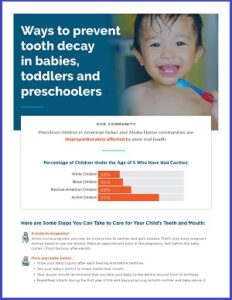Closing the Gap in Oral Health Disparities for Indigenous Children
November is Native American Heritage Month, which celebrates the history, heritage, traditions, and contemporary way of life of Native Americans, Alaska Natives, and Native Hawaiians. It is also a time to raise a general awareness about the unique challenges and inequities native people have faced both historically and in the present, and the ways in which they have worked to conquer these challenges.
Among North Americans, health disparities are particularly egregious among American Indian, Alaska Native, First Nations, Metis, and Inuit children. Rates of dental caries among Indigenous children are dismally high. This is especially poignant because dental disease is almost completely preventable.
Indigenous children haven’t always had such a high burden of tooth decay. A century ago, Indigenous peoples were known to have excellent oral health. So, what happened?
Disruptions in traditions and diet, poverty, residential schools, loss of cultural practices, and deleterious government policies have contributed to the increase in dental disease, exacerbating poor access to nutritious foods, low oral health literacy, limited access to dental care, and the lack of fluoridated drinking water.
Earlier this year, the American Academy of Pediatrics and the Canadian Paediatric Society published their joint policy statement on “Early Childhood Caries in Indigenous Communities”. This resource provides important recommendations to help close the gap in children’s oral health disparities. It includes guidance on preventive and clinical oral health care for infants, toddlers, preschool children, and pregnant women. Many of these can be delivered by primary health care providers.
The policy also addresses community-based health promotion initiatives including referral to dental professionals, fluoride varnish application, placement of sealants, and non-invasive dental procedures such as interim therapeutic restorations including silver diamine fluoride. And it advocates for future research on the microbiology, epidemiology, prevention, and management of caries in Indigenous communities that is community-based and takes into account the root causes of systemic disenfranchisement.
Collaboration is critical to address oral health disparities. Listening to the voices of Indigenous parents, elders, and communities is essential if we are to help improve oral health outcomes and delivery of care. Communities possess valuable insight into traditional teachings that can inform oral health messaging and information, ensuring that it is culturally appropriate and impactful.
Early childhood caries is preventable. Working together we can develop new approaches that will ultimately improve the oral health of young Indigenous children. Access and share these oral health promotion and disease prevention resources for Indigenous people of all ages!
Ways to prevent tooth decay in babies, toddlers, and preschoolers
Ways to protect teeth and prevent decay in school-age kids and teens

